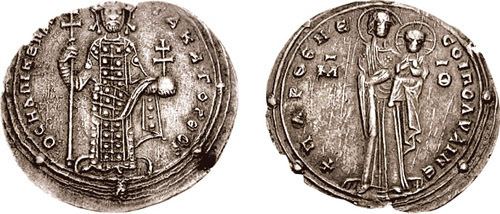Siblings Basil Argyros Died April 11, 1034, Byzantium | Name Romanos Argyros Nieces Helena Argyre | |
 | ||
Reign 15 November 1028 – 11 April 1034 Born 968 ( 0968 ) Spouse Zoe Porphyrogenita (m. 1028) Similar People Michael IV the Paphlagonian, Michael V Kalaphates, Romanos I Lekapenos, Constantine IX Monomachos, Basil II | ||
Romanos iii argyros
Romanos III Argyros, or Romanus III Argyrus (Greek: Ρωμανός Γ΄ Αργυρός, Rōmanos III Argyros; 968 – 11 April 1034), was Byzantine emperor from 15 November 1028 until his death.
Contents
- Romanos iii argyros
- Romanos III Argyros Wikipedia audio article
- Family and early career
- Reign
- Family
- References

Romanos III Argyros | Wikipedia audio article
Family and early career
Romanos Argyros was the son of an unnamed member of the Argyros family, who may be identifiable with the Pothos Argyros who defeated a Magyar raid in 958 (identified by some scholars with an older namesake) or with Eustathios Argyros, known only for commissioning a poem in honour of Romanos II in 950. Romanos' father was the son of another Romanos Argyros, who had married Agatha, a daughter of Romanos I Lekapenos (r. 919–944).
Romanos had several siblings: Basil Argyros, who served as general and governor under Basil II (r. 976–1025); Leo, who served under Basil and was killed in Italy in 1017; Pulcheria Argyropoulina, who married the magistros Basil Skleros; an anonymous sister who married Constantine Karantenos, who served as doux of Antioch under Romanos; and Maria Argyropoulina, who married Giovanni Orseolo, son of Doge Pietro II Orseolo.
Romanos was born in 968. Romanos served as krites (judge) in Opsikion, with the rank of protospatharios. In this capacity he persecuted heretics at Akmoneia. He was then promoted to the post of quaestor, and became one of the judges of the Hippodrome. In this role he is mentioned in the Peira, a compendium of legal decisions compiled by the notable jurist Eustathios Rhomaios. He was promoted further to the rank of patrikios and the post of oikonomos (steward) of the Great Church, while continuing to preside over a tribunal. At the time of the death of Basil II's successor, Emperor Constantine VIII, in 1028, he held the post of urban prefect of Constantinople.
Reign
Romanos attracted the attention of Constantine VIII, who forced him to divorce his wife (sending her into a monastery) and to marry the emperor's daughter Zoe Porphyrogenita. The marriage took place on 12 November 1028, and three days later Constantine VIII died, leaving Romanos III as emperor.
The new emperor showed great eagerness to make his mark as a ruler, but was mostly unfortunate in his enterprises. He spent large sums upon new buildings and in endowing the monks. His endeavour to relieve the pressure of taxation disorganized the finances of the state. Idealizing Marcus Aurelius, Romanos aspired to be a new "philosopher king", and similarly desired to imitate the military prowess of Trajan.
In 1030 he resolved to lead a large army in person against the Mirdasids of Aleppo. But by encamping his army in a waterless site and allowing his scouting party to be ambushed, he sustained a serious defeat at Azaz, near Antioch. Despite Romanos' tragic defeat, the Emir of Aleppo opened negotiations and signed a treaty which made Aleppo an Imperial tributary and allowed for a Greek governor to preside over the city.
In 1032, the capture and successful defence of Edessa by George Maniakes and the sound defeat of a Saracen fleet in the Adriatic did little to improve Romanos' early popularity.
As a member of the aristocracy, Romanos III abandoned his predecessors' curtailment of the privileges of the nobility and reduced their taxes, at the same time allowing peasant freeholders to fall into a condition of serfdom. In a vain attempt to reduce expenditure, Romanos limited his wife's expenses, which merely exacerbated the alienation between the two.
At home Romanos III faced several conspiracies, mostly centered on his sister-in-law Theodora, as in 1029 and 1030. Although he survived these attempts on the throne, his death on 11 April 1034 was supposed to have been due to poison administered by his wife, though there is also speculation that he was drowned in a bath on his wife's orders. He was buried in the Church of St. Mary Peribleptos, which he built.
Family
By his first wife Helena, Romanos III Argyros had a daughter, who was engaged to Henry III, Holy Roman Emperor. He had no children by his second wife Zoe.
